VeChain Review 2021: VET Still Worth It? This You NEED To Know
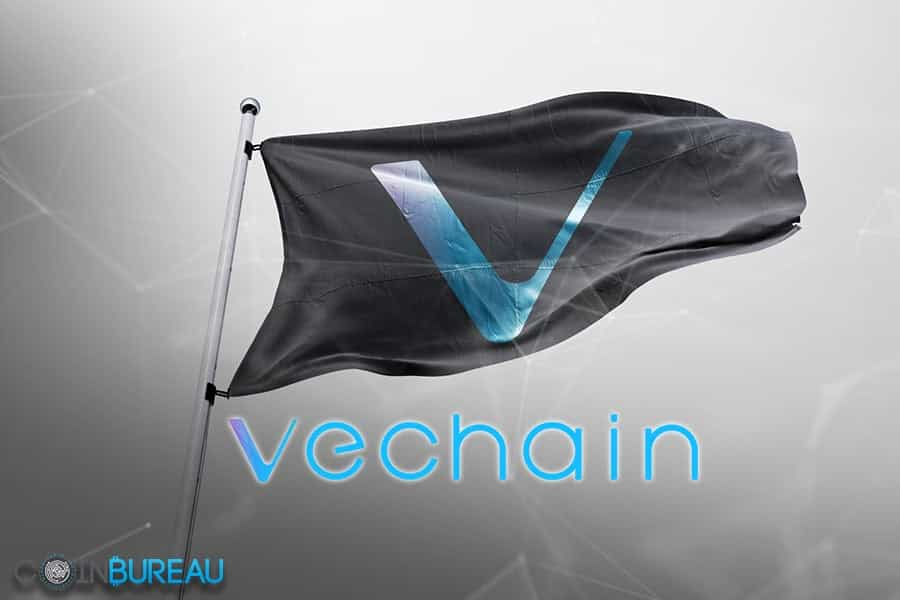
VeChain is one of the foremost supply chain focused blockchain projects currently out there. They continue getting quite a bit of attention since their main-net launch from June 2018
This was the mainnet launch that saw them release their native VET tokens that have seen increasing volume across a number of exchanges. However, VeChain is not alone in its supply chain focus and there are a number of companies and projects that have launched since then
So, with so much competition, is VeChain still worth considering?
In this VeChain review I will attempt to answer that. I will also analyse the use cases for the VET token and its potential for eventual mass adoption.
What is VeChain?
VeChain is an interesting spin on the uses of blockchain technology. Started in 2015, it is focused on business applications, primarily in the logistics field through supply chain management that provides tracking, quality control, inventory management, and much more.
The mainnet for VeChain was launched back in June 2018, and the project has pushed forward strongly since, bringing many partners into the VeChain ecosystem. In fact, hardly a month passes without the project announcing a new partnership or business that’s adopting the VeChain technology.
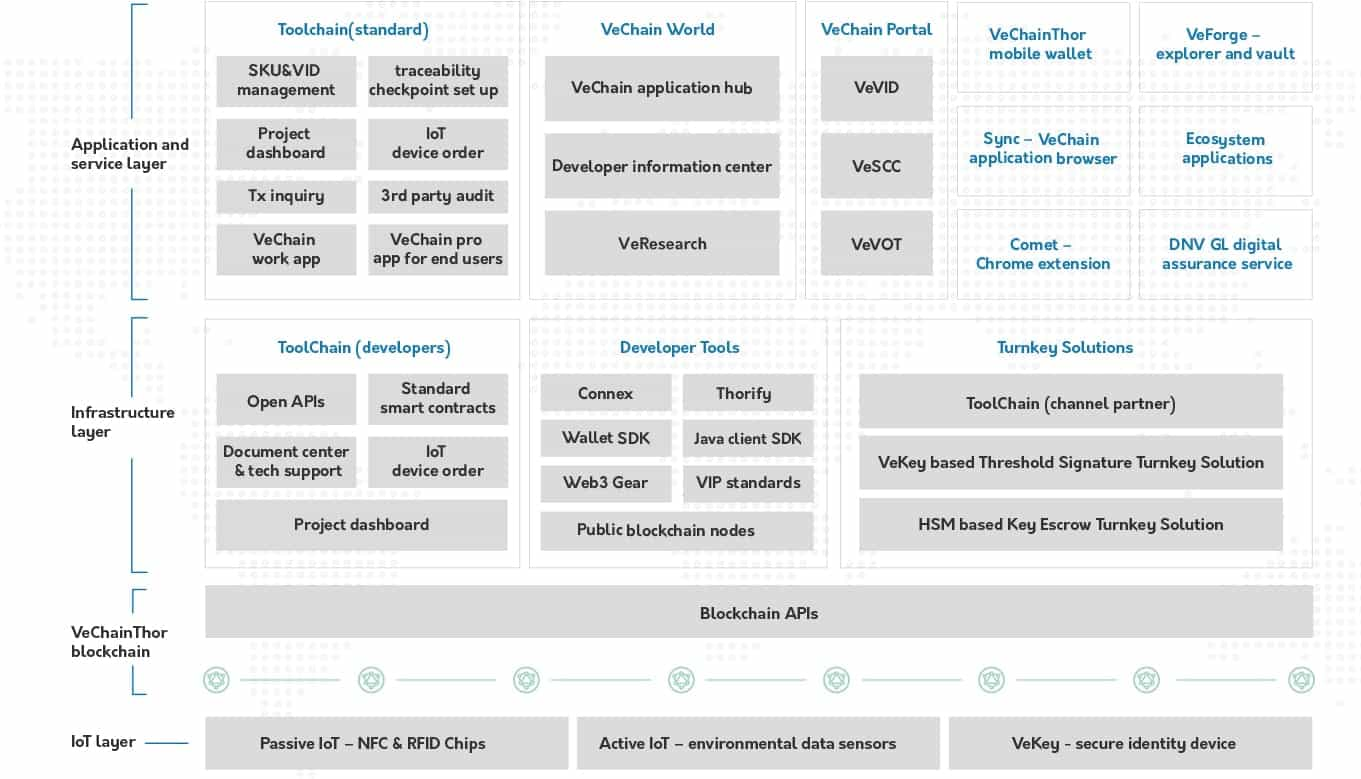
It has become a part of the Price Waterhouse Cooper incubation program, is working on a proof of concept with BMW and Renault, and has recently partnered with Australian winemaker Penfolds to provide proof of authenticity for their wines being delivered to China.
Unfortunately for investors all of these strong partnerships have had little impact on the price of the VET token, which fell throughout 2018, failed to mount much of a recovery in 2019 and early 2020, and then dropped again following the March 2020 meltdown in traditional financial markets.
Also of recent concern is the December 2019 hack in which roughly $6.5 million worth of VET tokens were stolen. We’ll discuss below how the hack played out, and whether it remains a security concern at this time.
The VeChain project has continued to forge ahead nonetheless, bringing new partnerships onboard, starting new pilot programs, and growing in the business space. This hasn’t been reflected in the token price yet, but it does point to increased adoption, which should eventually be reflected in the token price.
Proof of Authority 1.0 and 2.0
VeChain runs on a Proof of Authority (PoA) consensus model that requires nodes by authorized before they can participate in blockchain consensus. Once a node becomes authorized it joins the pool of other authorized nodes and each has an equal chance of publishing new blocks and receiving rewards. Under this system the rich nodes have no advantages, and there is no requirement for nodes to compete with one another and use vast amounts of resources.
The PoA system also features efficient bandwidth usage, which leads to higher throughput for the network. This equates to a greater number of transactions per second and increases the scalability of the network.

Although PoA has obvious advantages, and the VeChainThor blockchain continues to operate efficiently and securely, there are remaining limitations to this consensus method. One of these limitations is an inability to prevent a node from manipulating the entire system when it has the right to add a new block.
However there are ways the blockchain can trace any misbehavior and use it as evidence against the node later. Additionally, as part of the family of Nakamoto consensus methods, PoA only gives us a probabilistic assurance that transactions are secure. This could leave the network vulnerable to large-scale network partitioning.
Because of these limitations the VeChain Foundation is working on the next generation of Proof of Authority, which they are calling PoA 2.0. This new version of PoA will give the network the stability and security needed to support the growing number of business use cases on-chain. According to the VeChain Whitepaper 2.0 the new PoA 2.0 will deliver:
- Absolute finality (or safety guarantee) on blocks and transactions;
- significant reduction of the platform’s risk of being temporarily disrupted, which will result in better stability of blockchain service;
- faster-converging probabilistic finality, which will result in faster transaction confirmation for applications.
Late in 2020 the VeChain project announced they were close to delivering the improved Proof-of Authority 2.0 and would launch on testnet in 2021. VeChain’s chief scientist Peter Zhou tweeted the following:

VIP-193 is also known as SURFACE and it is planned to improve the scalability of the VeChain network while also speeding transaction confirmations. The improved PoA implementation will give VeChain all the strong points found in PoW blockchains while also making the blockchain more robust thanks to a Byzantine Fault Tolerance (BFT) mechanism.
What’s more, Zhou has made it clear that the prototyping of VIP-200 is now complete. VIP-200 is being created to make it possible for the VeChain distributed ledger to reach BFT finality by allowing blocks to carry extra finality related messages.
VeChain Governance and VeVote
Recently VeChain has also updated its governance model in oder to meet the needs of large enterprises, regulators, and government while maintaining its ability to scale. The new system was released this past November 11, 2019, and it gives VeChain a flexible governance model that will allow for rapid changes when needed.

The revised VeChain Governance Charter includes the following changes to the Articles of Association:
- Specified the scope of fundamental subjects that require all stakeholder voting;
- Redefined the categories of stakeholders with voting authority as Authority Masternode, Economic X Node and Economic Node;
- Adjusted the voting authority model according to the new stakeholder categorization;
- Streamlined the all stakeholder voting procedure.
In addition VeChain also introduced the VeVote platform as a way to increase governance transparency. VeVote is a decentralized voting platform and was adopted by a Steering Committee vote of 5-2 on December 13, 2019. The approval of the VeVote platform has also opened it up for use in voting by stakeholders.
VeChain describes VeVote as follows:
The VeVote platform provides an immutable, transparent and decentralized platform for stakeholders to cast their votes on important decisions based on their voting authority. The voting is done via VeVote smart contracts and the result will be recorded on the VeChainThor blockchain.
As of February 2021 there have been three proposals voted on and passed by the community and 1 proposal voted on and passed by the steering committee. Two of the three stakeholder votes were for contests and the third was to postpone the 2nd VeChain steering committee election to June 30, 2021. The steering committee vote was to update the VeChain Foundation Governance Charter.
The updated charter included the following major changes:
- Specified the scope of fundamental subjects that require all stakeholder voting
- Redefined the categories of stakeholders with voting authority as Authority Masternode, Economic X Node and Economic Node
- Adjusted the voting authority model according to the new stakeholder categorization
- Streamlined the all stakeholder voting procedure

The Sync 2 Wallet
Anyone who’s been using the internet knows what a web-based application is, whether the purpose is ecommerce, communications, or simply entertainment. And thanks to the development of the modern web browser these web apps are accessible across all types of hardware devices and operating systems.
While we would like to think that blockchain dApps are just as simple the truth is the technology isn’t there yet. Blockchain dApps for users to use specific browsers or wallets to access them, and users may need to switch the wallet or browser being used depending on the hardware or operating system being used. It’s really inconsistent and inconvenient for users.
Add to this the need to manage the crypto assets necessary for the dApp and pay gas fees, not to mention the need for a certain degree of technical savvy that’s needed when using decentralized platforms. All of this awkwardness, cost, and complexity has kept dApps as they are currently implemented from reaching mainstream adoption.
VeChain hopes to change all this with the introduction of the Sync 2 digital wallet app. The Sync 2, which was released in its alpha version in January 2021, provides the missing pieces of critical infrastructure in enabling the true mass adoption of dApp technology.
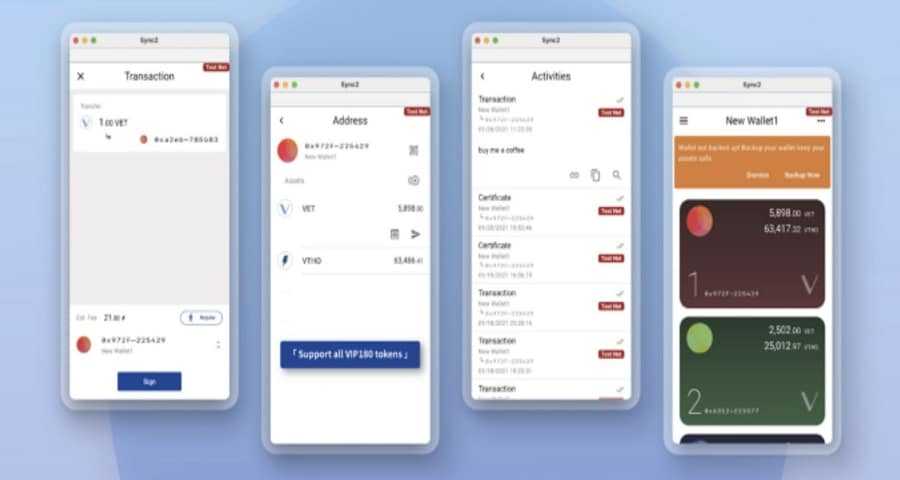
Sync 2 frees users from the restrictions of browser type, hardware, and OS and makes using dApps as simple and intuative as using any web-based app. In combination with VeChain’s native fee delegation protocols, users will no longer need to manage crypto to pay gas fees. Instead, dApp owners or DaaS service providers can fund gas fees on a user’s behalf.
Sync 2 is designed to work with all mainstream web browsers (e.g., Chrome, Safari, MS Edge, Firefox, etc), allowing dApps to be accessed by ever-greater numbers of users
It can be installed as a local app on desktop or mobile device, or used simply as a web application with no installation requirement, providing maximal flexibility and consistent user experience.
Put simply — Sync 2 is the missing jigsaw piece that enables a truly seamless dApp experience, paving the way for the mass adoption of decentralised applications by removing all barriers to entry. A first for the entire blockchain industry.
VeChain Partnerships
VeChain recognizes the importance of having an established business and client base, and with that in mind has been very active in creating partnerships. Through the end of the second quarter of 2019, there are no less than 31 partners which VeChain is working on pilots with, any of which could lead to a breakthrough and wider adoption of the blockchain. And they continue adding new partnerships.
A few of these partners are Price Waterhouse Cooper, Walmart China, LVMH Group, NTT Docomo, and most recently Australia’s leading wine producer Penfold’s.
Onboarding of new partners and clients is handled quite smoothly by VeChain since they operate on a Blockchain-as-a-Service model, and set up all the infrastructure for clients, including any necessary customization. It’s this model that has allowed VeChain to partner with such a broad and diverse group of industries.
The partnership with PwC has given VeChain access to many companies across China and Southeast Asia and has been valuable in spreading the word about VeChain.

With LVMH, VeChain is developing a system that tracks limited edition luxury goods. Pirating of these types of products is widespread, especially in China and Southeast Asia. With LVHM’s broad offerings of luxury goods, this is a perfect partnership.
VeChain has also been working with DNV GL to increase the transparency of products from the factory or farm to the consumer. In this partnership, VeChain has developed a blockchain-powered digital assurance solution they’ve called MyStory.
Using this dApp consumers are able to learn about the story behind a bottle of wine from the vineyard, to the bottler, through distribution, and to their store’s shelves. All this is accomplished by simply scanning a QR code on the wine bottle.
Another valuable partnership is the one with Chinese automaker BYD, where VeChain has been working on a proof of concept for handling carbon emission imbalances. This partnership is working on building a dApp that will track and record the emissions data of millions of cars, buses, trains, and other vehicles onto the public VeChain blockchain.
Most recently Vechain has been active in adding hospitals and tracking infection risk management in connection with the COVID-19 pandemic.
Not surprisingly these partnerships are helping VeChain grow, although it does remain smaller than major players such as Ethereum and EOS, who have more highly developed dApp ecosystems, with greater offerings of games and other applications.
The VeChain Team
The primary driving force behind the adoption of VeChain and the VET token is the VeChain Foundation, an organization founded in Singapore which governs and maintains the project, its development, and promotion. The Foundation is governed by the Steering Committee, which is elected every two years and is currently represented by the project founders.
Sunny Lu is the CEO of VeChain and one of the founding members of VeChain. Prior to founding VeChain, he was CIO at Louis Vuitton China. He has over a decade of experience working for Fortune 500 companies in executive IT positions.

Jay (Jie) Zhang was the CFO at VeChain, and is also a co-founder of the project. Due to the hack that occurred in December 2019, which he accepted full responsibility for, he has reportedly stepped down from his role as CFO, although the VeChain website still lists him as the project’s CFO. Prior to working at VeChain he was employed at Deloitte and prior to that he spent more than a dozen years with PwC. He was responsible for the design of the VeChain governance framework.
Kevin Feng is a partner at VeChain and acts as the COO of the project. He came to VeChain with over 12 years of experience working at PwC. His expertise is in risk assurance and cybersecurity, and he was a driving force behind the development of PwC’s blockchain services.
Jianliang Gu is the CTO at VeChain, coming from TCL & Alcatel’s R&D center he has more than 16 years of experience developing mobile hardware and software. He has amassed over 100 patents in the mobile communication field.
VET and VTHO Token Economics
VeChain is the type of blockchain which uses a dual token economic model in order to avoid the cost of transactions increasing when the value of the token rises. In the case of VeChain, there is a VET token used for speculation on exchanges and governance of the blockchain. The VET token is also used for staking and the generation of VTHO tokens.
The VTHO tokens are used to pay for network transactions, with the default transaction fee equal to 21 VTHO ($0.006719 as of February 20, 2021). Users can increase the number of VTHO paid for a transaction in order to increase its priority on the network. VTHO tokens can be purchased from exchanges, or they can be generated by holding VET in a wallet.
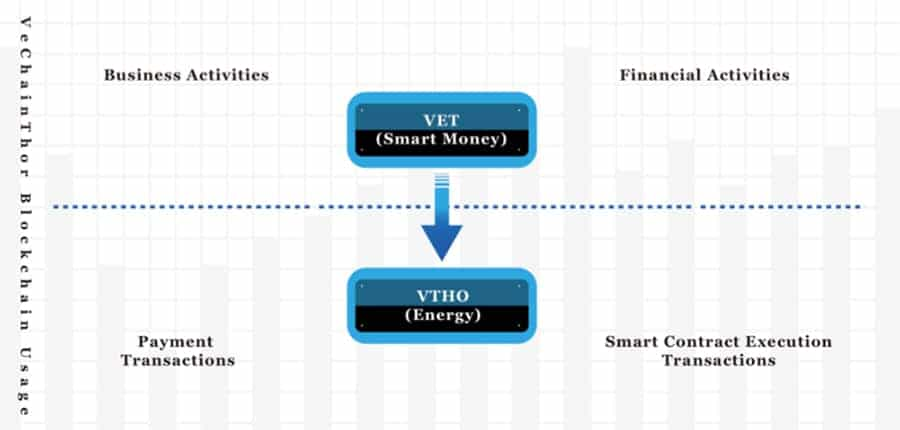
Both tokens are drastically different in terms of the function they serve, total supply, and inflation.
By using a dual token model such as this the network fees are kept separate from the potential volatility in the price of the VET token, which in turn makes the blockchain more suitable for business and enterprise uses.
Users who choose to hold VET in a wallet will generate VTHO over time, which enables them to make transactions for free in essence. One side effect of this is that it should increase demand for VET as the network usage grows.
Besides generating small amounts of VTHO it is possible to generate much larger amounts by running nodes to help support the network. There are three types of nodes in use, and each requires a substantial amount of VET.
Authority Nodes
These nodes participate directly in consensus and require a minimum of 25 million VET. In addition, the owners of authority nodes must be able to prove they are able to make a significant contribution to the VeChain ecosystem as well as passing stringent KYC measures.
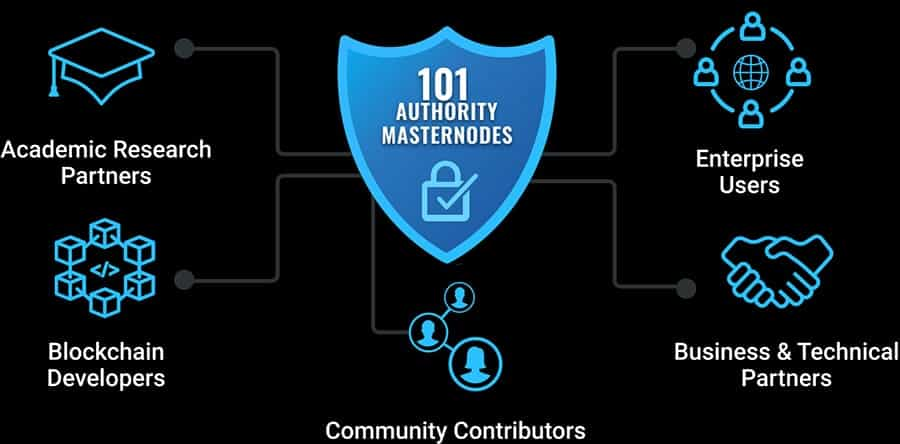
Authority masternodes are awarded 30% of the daily VTHO usage.
Economic Nodes
There are three different types, and while they don’t participate in consensus, they do provide network stability. Economic nodes receive a portion of VTHO generated by a pool of 15 billion VET set aside for this purpose.
The economic nodes also receive VTHO based on their VET stakes. The three types of economic nodes and staking requirements are the Mjolnir Masternode (15 million VET required), the Thunder Masternode (5 million VET required), and the Strength Masternode (1 million VET required).
X-Economic Nodes
These are nodes that supported VeChain in its early stages of development. They receive the VTHO generated by a pool of 5 billion VET set aside for this purpose. It’s no longer possible to create new X Economic nodes.
The VET Token
VeChain conducted their ICO on August 17, 2017, raising 200,000 ETH with tokens priced at $0.0008 each or 1 ETH = 3,500 VEN. Note that I said VEN and not VET.
The original tokens were ERC-20 tokens, but these were swapped for the native VET tokens at the ratio of 1:100 after the VeChain mainnet went live on June 30, 2018. At the time the VEN token was worth $1.62, making VET tokens worth $0.0162 each.
The all-time high also occurred while the VEN token existed and was $8.28 on January 23, 2018. That would be equivalent to $0.0828 for VET. The VET token only ever reached an all-time high of $0.06044 on February 13, 2021.
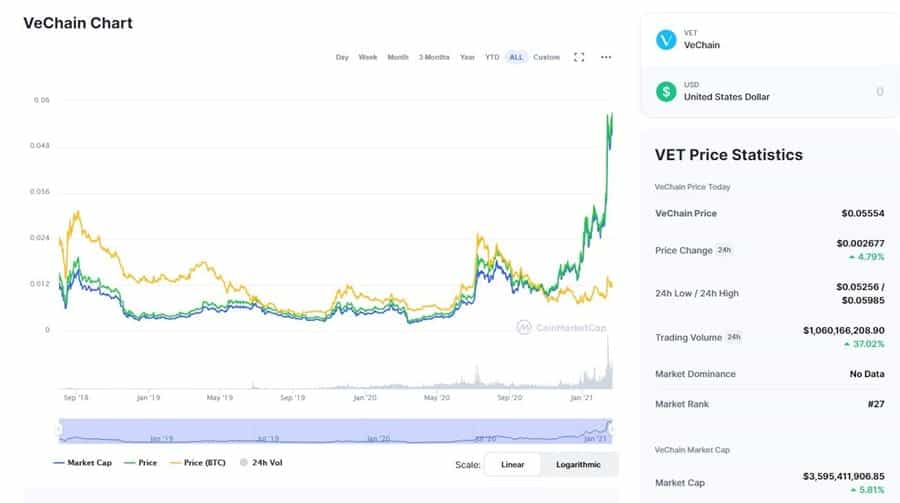
Price dropped following the swap to VET and dipped under $0.010 in August 2018, but recovered to trade between $0.010 and $0.015 until dropping again in November 2018. The all-time high for VET occurred during this period and was $0.019775.
Price remained below $0.01 until July 2020, although it nearly recovered that level in June 2019 and again in February 2020. Since July 2020 the VET token has been climbing strongly alongside the massive rally across nearly all altcoins. After hitting its all-time low of $0.001678 on March 13, 2020 the VET token has reached $0.057 as of late February 2021
Buying & Storing VET
There are a number of markets for the VET token as it is listed on quite a large range of exchanges. These include the likes of Binance, VCC Exchange, and LBank. There is strong volume on these exchanges which is more than I have seen for other coins of a similar market cap. While the trading volume for the token was once highly concentrated on just two exchanges that has changed and it is not actively traded on a number of exchanges, which helps with liquidity.
Taking a closer look at the individual order books it appears as if they are pretty robust. For example, below are the Binance BTC / VET order books. They are quite deep and there is a reasonable amount of daily turnover.

Once you have bought your VET tokens you are going to want to take them offline and store them in a wallet. We all know the risks that come from keeping tokens on large centralised exchanges.
Given that these are the native VET tokens, you don’t have too much choice for storage. We actually have a post on the best VeChain wallets. Perhaps your best bet for storage ought to be a secure hardware wallet.
Traditional Competition
While the threats from blockchain projects are currently minimal, there are players in the traditional technology sector that do pose a real threat already.
One of these is IBM, who have partnered with the shipping giant Maersk to create a global shipping management blockchain platform. This platform has attracted great interest already and has nearly 100 companies on-board, including ocean transport companies, logistics companies, ports, and others.

IBM has also begun work with Walmart and Unilever to uncover new areas of the supply chain that can benefit from blockchain technology. With its technological dominance and global reach, IBM is a threat that can’t be overlooked.
SAP is also entering the blockchain logistics space and is working with shipping and pharmaceutical companies to create a blockchain-based supply chain tracking system. SAP is another huge global player with massive resource and an extensive customer base to draw upon.
The most recent addition to traditional competition is coming from the world-famous auto manufacturer BMW. It’s interesting to note that BMW was one of the early partners of VeChain.
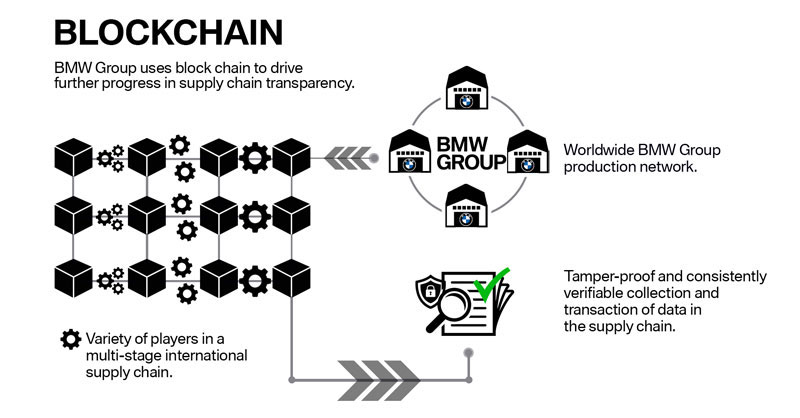
It has plans to roll out its blockchain supply chain solution to 10 of its suppliers sometime in 2020. Named “PartChain”, it was designed to ensure data transparency and trace-ability for automotive components throughout the supply chain.
This will be beneficial in the complex supply chains employed by BMW, where components are sourced from multiple international suppliers. Eventually BMW hopes to create “an open platform that will allow data within supply chains to be exchanged and shared safely and anonymized across the industry.” In the long-term they hope to bring tracking all the way to the raw materials used to create automotive components.
With all of that however VeChain maintains its lead in the space as of early 2021. There haven’t been any major developments reported from IBM, SAP, or BMW.

VeChain Opportunities and Threats
While VeChain is targeting several different markets, its core focus remains on the supply chain and logistics industries. It has also been developing its smart contract functionality and has its eyes on delivering Internet of Things solutions.
The focus on the supply chain industry makes sense, as this is a massive, multi-billion industry that can benefit immensely from the addition of blockchain technology.
VeChain has already forged several partnerships with luxury brands to develop blockchain tracking systems that will serve to maintain the authenticity of products, whether that be luxury handbags, premium wines, or the service history of automobiles.
One key to these tracking systems is the VeChain NFC chip. This tiny chip can be embedded in any product, and consumers are then able to scan products with their smartphone to confirm their authenticity. Counterfeiting of luxury goods is a huge problem globally, with some estimates claiming global counterfeiting affects some $1.2 trillion in goods annually.
Another area of strength for VeChain has been in the medical space. It’s tracking technology is now in use by a number of hospitals and other medical facilities. It is also making inroads into the food industry, as its tracking technology can be used to authenticate the freshness of highly perishable products such as seafood.
Oddly, the biggest threat competitively for VeChain is not other blockchain projects, although there is some competition from that direction, but rather from traditional companies.
In the crypto-space VeChain is up against competition from IOTA in the Internet of Things space, and from Waltonchain in supply chain management. But the adoption of these two projects remains low, and until we have a blockchain project that can scale a working case it isn’t likely there will be a leader in the blockchain space.
VeChain Development & Roadmap
There is no doubt that the VeChain team has been active making partnerships and rolling out updates, but how much of these work is actually reflected in the code?
Given that VeChain is an open source project it may make sense to go into their public code repositories. This can give you a good idea of just how much work is being done on the protocol.
Hence, I decided to dive into the VeChain GitHub and take a look at the coding activity in their repos. Below is the commit activity on two of their most active repos over the past year.
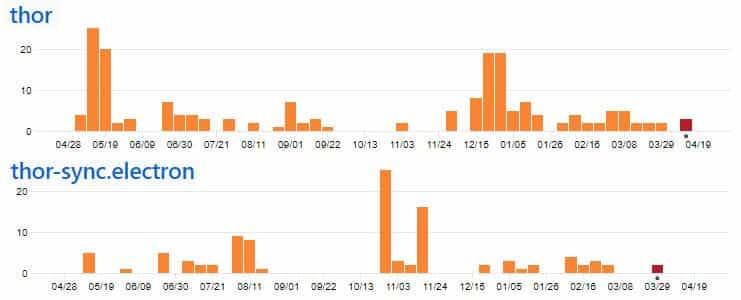
As you can see there has been a fairly low level of activity. This is below average for some of the other projects that I have covered. There are a further 35 repositories out there although these also have low levels of activity.
Looking forward, there are quite a few things that one can look forward to. While there is no official roadmap that has been laid out, you can glean some information from this blog post.
For example, the developers are actively working on cross chain interoperability of VeChain. They are currently still working on “technical preparations” for this technology. This interoperability could no doubt increase the adoption of VeChain.
Then, there is further studies that are being done on the eventual implementation of anonymous transactions. This will be through the use of Bulletproof technology that has already being popularized on the likes of Monero (XMR). Of course as of February 2021 the most highly anticipated upgrade to VeChain is the launch of PoA 2.0.
If you want to keep up to date with the project development then you should keep your eyes on their official blog as well as their Twitter account.
Conclusion
There’s no doubt that VeChain has been one of the most successful blockchain projects in terms of generating partnerships. With pilot projects ongoing for nearly 3 dozen companies VeChain is beginning to see some successes. If it can build on those it could see increased adoption.
The project is well-thought out, with good governance, and a unique economic model that works very well when taking into account the needs of large organizations and enterprise customers. It also hasn’t faced the scalability issues common at many blockchain projects, although that could be due to lack of adoption.
It’s also been able to successfully get past the December 2019 hacking issue, which could have been a major concern for the VeChain community.
With all the successes VeChain has had, there is still the threat of competition faced from large traditional technology companies such as IBM, BMW,and SAP. Investors are understandably worried that VeChain will be buried by these mammoth companies. The VET token has been able to make strong gains during the altcoin rally of 2021, but if VeChain can’t establish a dominant position in the logistics space soon investors could lose their optimism for the project.
The coming year will be a crucial one for VeChain. If it can get PoA 2.0 launched it will have the means to attract more high-profile clients. It remains ahead of the major traditional companies working in this space, but maintaining that momentum will be key to keeping VeChain in the lead.
Disclaimer: These are the writer’s opinions and should not be considered investment advice. Readers should do their own research.
source https://movsa.org/vechain-review-2021-vet-still-worth-it-this-you-need-to-know/
Nhận xét
Đăng nhận xét